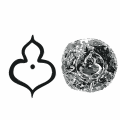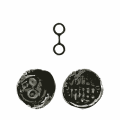塔木加
来自维基百科,自由的百科全书
塔木加(古突厥语:𐱃𐰢𐰍𐰀,tamga; 鄂图曼土耳其语:طمغا,damga; 蒙古语:ᠲᠠᠮᠠᠭᠠ,西里尔字母:тамга),是欧亚游牧民族和受其影响的文化所使用的抽象印记。通常是一个特定的部落,氏族或家庭的象征。他们在古代和中世纪(包括阿兰、萨尔马提亚人,斯基泰人、突厥人和蒙古人)的欧亚游牧民族中很常见。
此条目需要补充更多来源。 (2023年10月23日) |
这些印记符号有时被东欧和中亚邻近里海-钦察草原的定居民族采用。考古学家认为,塔木加是研究现在和灭绝民族文化的第一手来源。
这些印记在游牧民族中主要用在确定牲畜所属权,用热铁在牲口上加盖塔木加可防止牲畜被盗。塔木加也用在部落旗帜和牧场界石上。
在蒙古和俄罗斯,“塔木加”这字主要解作印章。
在土耳其人定居安纳托利亚后,逐渐放弃游牧生活,但土耳其帝国仍保留了他们的塔木加符号“弓”,并最终被简化成一个新月的图形。
乌古斯塔木加
根据学者喀什噶里所著的突厥语大词典中的介绍中指出,乌古斯人部落当中共有二十二个部落拥自己的塔木加。
| 部落 | 中古突厥语 | 含意 | 塔木加 |
|---|---|---|---|
| 卡耶 | Kayığ (قَيِغْ) | 强壮 | |
| 巴岳特 | Bayat (بَياتْ) | 尊严 | |
| 阿尔喀伯吕克 | Alkabölük (اَلْقابُلُكْ) | 白帐 | |
| 喀喇伯吕克 | Karabölük (قَرَبُلُكْ) | 黑帐 | |
| 亚兹吉尔 | Yazgır (ىَزْغِرْ) | 多国 | |
| 突盖尔 | Tüger (تُوكَرْ) / (ثُكَرْ) | 积累 | |
| 图梯尔卡 | Tutırka (تُوتِرْقا) | 立法会议 | |
| Yaparlı | 好闻地 | ||
| 阿夫沙尔 | Afşar (اَفْشارْ) | 好猎手 | |
| Qiziq | 刚毅 | ||
| 贝克特里 | Begtili (بَكْتِلى) | 尊敬 | |
| Karkın | 洋溢 | ||
| 伯颜都儿 | Bayundur (بايُنْدُرْ) | 蒙福 | |
| 佩切涅格 | Beçenek (بَجَنَكْ) | 勇士 | |
| 昭武达尔 | Çuvaldar (جُوَلْدَرْ) | 敏捷尊贵或牧民 | |
| 契比尼 | Çepni (جَبْني) | 攻击敌人者 | |
| 撒鲁尔 | Salgur (سَلْغُرْ) | 挥剑者 | |
| 埃伊米尔 | Eymür (اَيْمُرْ) | 富裕 | |
| 乌鲁云德鲁格 | Ulayundluğ (اُوﻻيُنْدْلُغْ) | 骑花斑马的剑士 | |
| 于雷吉尔 | Üregir (اُرَكِرْ)
Yüregir (يُرَكِرْ) |
奠基者 | |
| 伊格迪尔 | İgdir (اِكْدِرْ) | 伟大 | |
| 比格迪兹 | Bügdüz (بُكْدُزْ) | 谦逊 | |
| 厄瓦 | Iwa (اِڤـا)
Yıwa (يِڤـا) |
至高 | |
| 克尼克 | Kınık (قِنِقْ) | 可敬 |
蒙古塔木加
参考文献
- Brook, Kevin Alan. The Jews of Khazaria 3d ed. Rowman and Littlefield. 2018. ISBN 9781538103425 (英语).
- Golden, Peter B. The Türk Imperial Tradition in the Pre-Chinggisid Era. Sneath, David; Kaplonski, Christopher (编). The History of Mongolia. Brill. 2006: 68–95. doi:10.1163/9789004216358_005 (英语).
- Jacobson-Tepfer, Esther. Monumental Archaeology in the Mongolian Altai: Intention, Memory, and Myth. Brill. 2023. ISBN 978-90-04-53521-3 (英语).
- Reychman, Jan; Zajączkowski, Ananiasz. Handbook of Ottoman-Turkish Diplomatics. Mouton. 1968 (英语).
参见
Wikiwand - on
Seamless Wikipedia browsing. On steroids.





